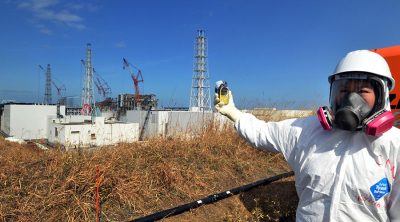Fukushima Radiation Levels 100 Times Higher Than Normal, Greenpeace Warns

Seven years after a 9.1-magnitude earthquake and the resulting tsunami triggered the catastrophic disaster at the Fukushima Daiichi nuclear power plant, the people, towns and villages in the surrounding area are still being exposed to excessive levels of radiation, according to a Greenpeace report.
“This is public land. Citizens, including children and pregnant women returning to their contaminated homes, are at risk of receiving radiation doses equivalent to one chest X-ray every week. This is unacceptable and a clear violation of their human rights,” said Jan Vande Putte, leader of the survey, from Greenpeace Belgium.
The survey states that in the towns of Namie and Iitate, approximately 10km and 40km respectively from the Fukushima plant, radiation levels continue to be “up to 100 times higher than the international limit for public exposure”.
Greenpeace also noted the “ineffectiveness of decontamination work” in these areas, saying there remained a “significant risk to health and safety for any returning evacuee”, adding that Tokyo’s policy of “effectively forcing people to return by ending housing and other financial support is not working”.
The Japanese government claims that radiation levels in the reopened zones pose no risk to human health and that its own data has been corroborated by the country’s medical experts as well as the United Nations Scientific Committee on the Effects of Atomic Radiation.
Greenpeace’s announcement coincides with a new ground-level study conducted by an international research team – including scientists from the University of Manchester – which found that uranium and other radioactive materials, such as caesium and technetium, were present in tiny particles released from the damaged nuclear reactors.
This could mean that the environmental impact from the fallout may last much longer than previously expected. The team said that, for the first time, the fallout of Fukushima Daiichi nuclear reactor fuel debris into the surrounding environment has been “explicitly revealed” by its study, published in the journal Environmental Science and Technology.
The scientists looked at extremely small pieces of debris, known as micro-particles, released into the environment during the initial disaster in 2011. The researchers discovered uranium from nuclear fuel embedded in or associated with caesium-rich micro particles that were emitted from the plant’s reactors during the meltdowns. The particles measure just five micrometres or less (approximately 20 times smaller than the width of a human hair) and are easily inhaled by humans.
It had been thought that only volatile, gaseous radionuclides, such as caesium and iodine, were released from the damaged reactors. It is now becoming clear that small, solid particles were also emitted and that some of these particles contain very long-lived radionuclides. Uranium, for example, has a half-life of billions of years.
Dr Gareth Law, senior lecturer in Analytical Radiochemistry at the University of Manchester and one of the authors on the paper, said:
“Our research strongly suggests there is a need for further detailed investigation on Fukushima fuel debris, inside, and potentially outside, the nuclear exclusion zone. While it is extremely difficult to get samples from such an inhospitable environment, further work will enhance our understanding of the long-term behaviour of the fuel debris nano-particles and their impact.”
The Tokyo Electric Power Company (TEPCO) is currently responsible for the clean-up and decommissioning process at the Fukushima Daiichi site and in the surrounding exclusion zone.
Getting chemical data on the melted nuclear fuel debris within the damaged nuclear reactors is practically impossible due to the high levels of radiation. The microparticles found by the international team of researchers should provide vital clues on the decommissioning challenges that still lie ahead.

